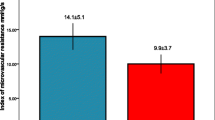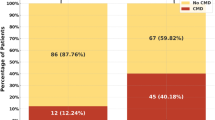Abstract
Purpose
In patients undergoing primary percutaneous coronary intervention (PCI) for the treatment of ST-segment elevation myocardial infarction (STEMI), coronary microvascular dysfunction is associated with poor prognosis. Coronary microvascular resistance is predominantly regulated by ATP-sensitive potassium (KATP) channels. The aim of this study wasto clarify whether nicorandil, a hybrid KATP channel opener and nitric oxide donor, may be a good candidate for improving microvascular dysfunction even when administered after primary PCI.
Methods
We compared the beneficial effects of nicorandil and nitroglycerin on microvascular function in 60 consecutive patients with STEMI. After primary PCI, all patients received single intracoronary administrations of nitroglycerin (250 μg) and nicorandil (2 mg) in a randomized order; 30 received nicorandil first, while the other 30 received nitroglycerin first. Microvascular dysfunction was evaluated with the index of microcirculatory resistance (IMR), defined as the distal coronary pressure multiplied by the hyperemic mean transit time.
Results
As a first administration, nicorandil decreased IMR significantly more than did nitroglycerin (median [interquartile ranges]: 10.8[5.2–20.7] U vs. 2.1[1.0–6.0] U, p = 0.0002).As a second administration, nicorandil further decreased IMR, while nitroglycerin did not (median [interquartile ranges]: 6.0[1.3–12.7] U vs. −1.4[−2.6 to 1.3] U, p < 0.0001). The IMR after the second administration was significantly associated with myocardial blush grade, angiographic TIMI frame count after the procedure, and peak creatine kinase level.
Conclusion
Intracoronary nicorandil reduced microvascular dysfunction after primary PCI more effectively than did nitroglycerin in patients with STEMI, probably via its KATP channel-opening effect.



Similar content being viewed by others
References
Ito H, Maruyama A, Iwakura K, et al. Clinical implications of the ‘no reflow’ phenomenon. A predictor of complications and left ventricular remodeling in reperfused anterior wall myocardial infarction. Circulation. 1996;93:223–8.
Prasad A, Stone GW, Holmes DR, Gersh B. Reperfusion injury, microvascular dysfunction, and cardioprotection: the “dark side” of reperfusion. Circulation. 2009;120:2105–12.
Ito N, Nanto S, Doi Y, et al. High index of microcirculatory resistance level after successful primary percutaneous coronary intervention can be improved by intracoronary administration of nicorandil. Circ J. 2010;74:909–16.
Fearon WF, Balsam LB, Farouque HM, et al. Novel index for invasively assessing the coronary microcirculation. Circulation. 2003;107:3129–32.
McGeoch R, Watkins S, Berry C, et al. The index of microcirculatory resistance measured acutely predicts the extent and severity of myocardial infarction in patients with ST-segment elevation myocardial infarction. JACC Cardiovasc Interv. 2010;3:715–22.
Fearon WF, Shah M, Ng M, et al. Predictive value of the index of microcirculatory resistance in patients with ST-segment elevation myocardial infarction. J Am CollCardiol. 2008;51:560–5.
Lim HS, Yoon MH, Tahk SJ, et al. Usefulness of the index of microcirculatory resistance for invasively assessing myocardial viability immediately after primary angioplasty for anterior myocardial infarction. Eur Heart J. 2009;30:2854–60.
Kern MJ, Miller JT, Henry RL. Dose-related effects of intracoronary nitroglycerin on coronary hyperemia in patients with coronary artery disease. Am Heart J. 1986;111:845–52.
Kurz MA, Lamping KG, Bates JN, et al. Mechanisms responsible for the heterogeneous coronary microvascular response to nitroglycerin. Circ Res. 1991;68:847–55.
Sakata Y, Kodama K, Komamura K, et al. Salutary effect of adjunctive intracoronary nicorandil administration on restoration of myocardial blood flow and functional improvement in patients with acute myocardial infarction. Am Heart J. 1997;133:616–21.
De Bruyne B, Pijls NH, Smith L, Wievegg M, Heyndrickx GR. Coronary thermodilution to assess flow reserve: experimental validation. Circulation. 2001;104:2003–6.
Gibson CM, Cannon CP, Murphy SA, et al. Relationship of TIMI myocardial perfusion grade to mortality after administration of thrombolytic drugs. Circulation. 2000;101:125–30.
Costantini CO, Stone GW, Mehran R, et al. Frequency, correlates, and clinical implications of myocardial perfusion after primary angioplasty and stenting with and without glycoprotein IIb/IIIa inhibition in acute myocardial infarction. J Am CollCardiol. 2004;44:305–12.
Rentrop KP, Cohen M, Blanke H, Phillips RA. Changes in collateral channel filling immediately after controlled coronary artery occlusion by an angioplasty balloon in human subjects. J Am CollCardiol. 1985;5:587–92.
Doddi S, Marathe A, Ravi SS, Torney DC. Discovery of association rules in medical data. Med Inform Internet Med. 2001;26:25–33.
The Committee of the Japan Diabetes Society on the diagnostic criteria of diabetes mellitus. Report of the Committee on the classification and diagnostic criteria of diabetes mellitus. Diabetol Int 2010;1:2–20.
Ishii H, Ichimiya S, Kanashiro M, et al. Impact of a single intravenous administration of nicorandil before reperfusion in patients with ST-segment-elevation myocardial infarction. Circulation. 2005;112:1284–8.
Ito H, Taniyama Y, Iwakura K, et al. Intravenous nicorandil can preserve microvascular integrity and myocardial viability in patients with reperfused anterior wall myocardial infarction. J Am Coll Cardiol. 1999;33:654–60.
Iwakura K, Ito H, Okamura A, et al. Nicorandil treatment in patients with acute myocardial infarction: a meta-analysis. Circ J. 2009;73:925–31.
Taira N. Nicorandil as a hybrid between nitrates and potassium channel activators. Am J Cardiol. 1989;63:18J–24J.
Chilian WM, Eastham CL, Marcus ML. Microvascular distribution of coronary vascular resistance in beating left ventricle. Am J Physiol. 1986;251:H779–88.
Komaru T, Lamping KG, Eastham CL, Dellsperger KC. Role of ATP-sensitive potassium channels in coronary microvascular autoregulatory responses. Circ Res. 1991;69:1146–51.
Akai K, Wang Y, Sato K, et al. Vasodilatory effect of nicorandil on coronary arterial microvessels: its dependency on vessel size and the involvement of the ATP-sensitive potassium channels. J Cardiovasc Pharmacol. 1995;26:541–7.
Nakae I, Quan L, Hashimoto K, et al. Mechanism of the vasodilatory action of nicorandil on coronary circulation in dogs. Cardiovasc Drugs Ther. 1994;8:137–45.
Okamura A, Rakugi H, Ohishi M, et al. Additive effects of nicorandil on coronary blood flow during continuous administration of nitroglycerin. J Am Coll Cardiol. 2001;37:719–25.
Haager PK, Klues HG, Schmidt M, vom Dahl J, Hanrath P. Effects of nitroglycerin and nicorandil on regional poststenotic quantitative coronary blood flow in coronary artery disease: a combined digital quantitative angiographic and intracoronary Doppler study. J CardiovascPharmacol. 1999;33:126–34.
Sadamatsu K, Tashiro H, Yoshida K, et al. Acute effects of isosorbide dinitrate and nicorandil on the coronary slow flow phenomenon. Am J Cardiovasc Drugs. 2010;10:203–8.
Hayashi T, Ichikawa M, Iwata A, et al. Intracoronary nicorandil relieves multiple coronary vasospasm with hemodynamic collapse. Circ J. 2008;72:327–30.
Ng MK, Yeung AC, Fearon WF. Invasive assessment of the coronary microcirculation: superior reproducibility and less hemodynamic dependence of index of microcirculatory resistance compared with coronary flow reserve. Circulation. 2006;113:2054–61.
Nakatani D, Sato H, Sakata Y, et al. Effect of intracoronary thrombectomy on 30-day mortality in patients with acute myocardial infarction. Am J Cardiol. 2007;100:1212–7.
Svilaas T, Vlaar PJ, van der Horst IC, et al. Thrombus aspiration during primary percutaneous coronary intervention. N Engl J Med. 2008;358:557–67.
Nestler DM, Noheria A, Haro LH, et al. Sustaining improvement in door-to-balloon time over 4 years. The Mayo Clinic ST-elevation myocardial infarction protocol. Circ Cardiovasc Qual Outcomes. 2009;2:508–13.
Zeymer U, Margenet A, Haude M, et al. Randomized comparison of eptifibatide versus abciximab in primary percutaneous coronary intervention in patients with acute ST-segment elevation myocardial infarction: results of the EVA-AMI trial. J Am CollCardiol. 2010;56:463–9.
Taniyama Y, Ito H, Iwakura K, et al. Beneficial effect of intracoronary verapamil on microvascular and myocardial salvage in patients with acute myocardial infarction. J Am Coll Cardiol. 1997;30:1193–9.
Huang RI, Patel P, Walinsky P, et al. Efficacy of intracoronary nicardipine in the treatment of no-reflow during percutaneous coronary intervention. Catheter Cardiovasc Interv. 2006;68:671–6.
Pasceri V, Pristipino C, Pelliccia F, et al. Effects of the nitric oxide donor nitroprusside on no-reflow phenomenon during coronary interventions for acute myocardial infarction. Am J Cardiol. 2005;95:1358–61.
Henry PJ, Horowitz JD, Louis WJ. Nitrate tolerance induced by nicorandil or nitroglycerin is associated with minimal loss of nicorandil vasodilator activity. J Cardiovasc Pharmacol. 1990;15:365–70.
Acknowledgments
We are greatly indebted to all of Osaka Saiseikai Senri Hospital personnel.
Conflict of Interest Statement
All authors declare no conflicts of interest.
Grant support
None.
Author information
Authors and Affiliations
Corresponding author
Electronic supplementary material
Below is the link to the electronic supplementary material.
10557_2013_6456_MOESM1_ESM.jpg
Supplement Figure Contributor of improving IMR. (Figure A) From Baseline to P1 (Figure B) From P1 to P2.IMR measurement was performed following PCI (baseline), after administration of nitroglycerin (P1), and after administration of nicorandil (P2). Nic group: IMR measurement was performed following PCI (Baseline), after administration of nicorandil (P1), and after administration of nitroglycerin (P2). Open boxes are NTG group and black boxes are Nic group. Spearman correlation analysis was performed to assess correlations. IMR = index of microcirculatory resistance; MBP = mean blood pressure; Tmn = hyperemic mean transit time (JPEG 64 kb)
Rights and permissions
About this article
Cite this article
Ito, N., Nanto, S., Doi, Y. et al. Beneficial Effects of Intracoronary Nicorandil on Microvascular Dysfunction After Primary Percutaneous Coronary Intervention: Demonstration of Its Superiority to Nitroglycerin in a Cross-Over Study. Cardiovasc Drugs Ther 27, 279–287 (2013). https://doi.org/10.1007/s10557-013-6456-y
Published:
Issue Date:
DOI: https://doi.org/10.1007/s10557-013-6456-y




